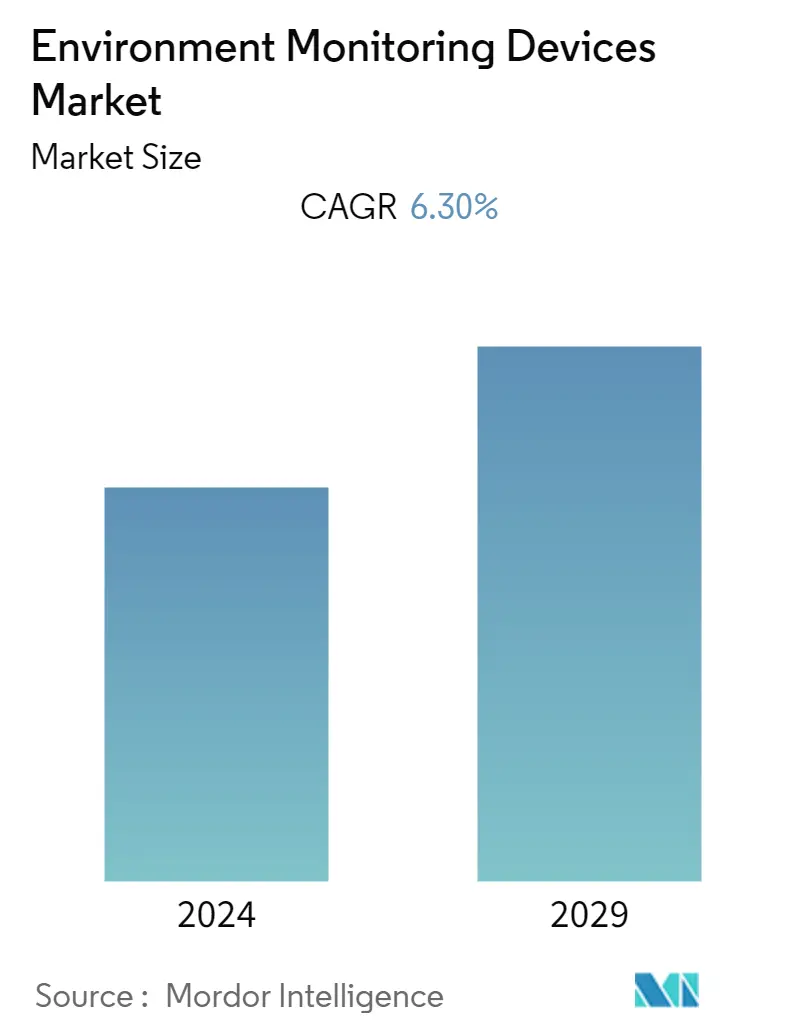Market Size of Environment Monitoring Devices Industry

| Study Period | 2019 - 2029 |
| Base Year For Estimation | 2023 |
| CAGR | 6.30 % |
| Fastest Growing Market | Asia-Pacific |
| Largest Market | North America |
| Market Concentration | Low |
Major Players
*Disclaimer: Major Players sorted in no particular order |
Environment Monitoring Devices Market Analysis
The environment monitoring devices market is anticipated to register a CAGR of 6.3% over the forecast period. Environmental monitoring is used for multiple applications, such as detecting and tracking changes in temperature, humidity, particulate matter, biological and chemical air pollutants, water quality, and noise level. These systems use multiple types of sensors to check the attributes mentioned above and inform and alert users if pollution levels increase. The process also involves collecting and measuring pollutants to assess an environment's status. Further, this helps users accurately understand the natural environment and facilitate the development of policies and measures to protect it from any adverse outcomes of human activity.
- Emerging wireless cellular and non-cellular communication technologies have enabled users to deploy environment monitoring systems in confined places, remote locations, and difficult-to-access terrain. This has allowed governments to effectively trace and track water contamination and pollution levels at the source of occurrence.
- Also, rapidly rising pollution levels due to increased industrialization and urbanization have compelled businesses and governments to deploy new environmental monitoring stations. It has also enabled companies to effectively check and establish environmental baseline standards and trends to support the development of policies and regulations.
- The emergence of big data analytics has enabled companies to effectively analyze large volumes of data obtained from multiple environment monitoring networks. Technological advancements in sensor technology and a decline in sensor prices have also emerged as significant factors driving the adoption of environmental monitoring systems worldwide. Furthermore, developing IoT-specific cellular network connectivity solutions such as LTE-M and NB-IoT and non-cellular communication technologies such as sigfox and LoRaWAN is also a significant factor driving the market.
- Recently, ATMO, a company building air quality and environmental monitoring products, announced the launch of Atmocube, an indoor air quality monitoring system for businesses, commercial buildings, and public spaces.
- In October 2022, NatureMetrics, the global nature intelligence technology company, launched 'PollutionTracker,' a monthly subscription service for water pollution, combining unique DNA sampling with state-of-the-art data science to deliver mapping of bacterial pollution across whole river catchments.
Environment Monitoring Devices Industry Segmentation
Environmental monitoring is a process of monitoring the environment, which involves assessing the environment's quality to reduce the danger of pollution. The main objective of environmental monitoring is to manage and minimize the impact an organization's activities have on an environment, either to ensure compliance with laws and regulations or to mitigate risks of harmful effects on the natural environment and protect the health of human beings.
The studied market is segmented by type of material (silicon carbide, gallium manganese arsenide, copper indium gallium selenide, molybdenum disulfide, and bismuth telluride), application (fabrication (process chemicals, photomasks, electronic gases, photoresists ancillaries, sputtering targets, silicon, and other fabrication materials)), packaging (substrates, lead frames, ceramic packages, bonding wire, encapsulation resins, die attach materials, and other packaging types), end-user industry (consumer electronics, telecommunication, manufacturing, automotive, energy and utility, and other end-user industries) and geography (Taiwan, South Korea, China, Japan, and Rest of Asia-Pacific). The market sizes and forecasts are provided in terms of value (USD million) for all the above segments. Further, to arrive at the overall market projections, the study analyzes the impact of COVID-19 and the investment scenario and other macroeconomic factors.
| Product Type | |||||
| Sensors | |||||
|
| Application | |
| Air Pollution Monitoring | |
| Water Pollution Monitoring | |
| Soil Pollution Monitoring | |
| Noise Pollution Monitoring |
| Geography | |
| North America | |
| Europe | |
| Asia-Pacific | |
| Rest of the World |
Environment Monitoring Devices Market Size Summary
The environment monitoring devices market is poised for significant growth, driven by the increasing need to monitor and manage environmental conditions such as air and water quality, noise levels, and pollution. These devices utilize advanced sensor technologies to detect changes in environmental parameters, enabling users to take informed actions to mitigate adverse effects. The proliferation of wireless communication technologies has further enhanced the deployment of these systems in remote and challenging locations, facilitating real-time monitoring and data collection. The rise in industrialization and urbanization has intensified pollution levels, prompting both governmental and corporate entities to invest in environmental monitoring solutions to establish baseline standards and inform policy development. The integration of big data analytics and IoT connectivity solutions has also played a crucial role in advancing the capabilities and adoption of these devices globally.
The market for air pollution monitoring devices, in particular, has seen a steady increase due to heightened awareness of air quality issues and the implementation of stringent regulations. Companies are actively developing and launching innovative monitoring solutions, such as advanced air quality sensors and indoor air quality systems, to address these challenges. Government initiatives and collaborations with private sector players have further bolstered the market, as seen in various projects aimed at enhancing air quality awareness and monitoring. In North America, regulatory bodies like the EPA and OSHA have driven the adoption of these devices, ensuring compliance with environmental and safety standards. The competitive landscape is characterized by the presence of numerous players, with major companies continuously investing in research and development to introduce cutting-edge monitoring technologies.
Environment Monitoring Devices Market Size - Table of Contents
-
1. MARKET INSIGHTS
-
1.1 Market Overview
-
1.2 Industry Attractiveness - Porter's Five Forces Analysis
-
1.2.1 Bargaining Power of Suppliers
-
1.2.2 Bargaining Power of Consumers
-
1.2.3 Threat of New Entrants
-
1.2.4 Intensity of Competitive Rivalry
-
1.2.5 Threat of Substitutes
-
-
1.3 Industry Value Chain Analysis
-
1.4 An Assessment of the impact of COVID-19 on the Industry
-
-
2. MARKET SEGMENTATION
-
2.1 Product Type
-
2.1.1 Sensors
-
2.1.2 Monitors
-
2.1.2.1 Indoor
-
2.1.2.2 Outdoor
-
2.1.2.3 Portable
-
-
-
2.2 Application
-
2.2.1 Air Pollution Monitoring
-
2.2.2 Water Pollution Monitoring
-
2.2.3 Soil Pollution Monitoring
-
2.2.4 Noise Pollution Monitoring
-
-
2.3 Geography
-
2.3.1 North America
-
2.3.2 Europe
-
2.3.3 Asia-Pacific
-
2.3.4 Rest of the World
-
-
Environment Monitoring Devices Market Size FAQs
What is the current Environment Monitoring Devices Market size?
The Environment Monitoring Devices Market is projected to register a CAGR of 6.30% during the forecast period (2024-2029)
Who are the key players in Environment Monitoring Devices Market?
Agilient Technologies, Inc., Danaher Corporation, Thermo Fisher Scientific Inc., Shimadzu Corporation and Perkinelmer, Inc. are the major companies operating in the Environment Monitoring Devices Market.

